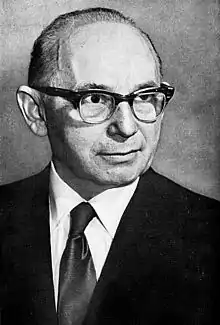Aron Brand Auraban | |
|---|---|
 Prof. Aron Brand-Auraban | |
| Born | 21 February 1910 Ozorków, Poland |
| Died | 22 April 1977 (aged 67) Israel |
| Nationality | Israeli |
| Occupation | Pediatric cardiologist |
| Spouse | Esther Malka (Mala) Brand |
Aron Brand-Auraban (21 February 1910 – 22 April 1977) was an Israeli pediatric cardiologist. He served as chairman of the Israel Medical Association in Jerusalem, and founded the Jerusalem Academy of Medicine.[1]
Biography
Aron Brand grew up in Koło, where he attended heder and the Jewish gymnasium. His father, Natan, was a grain merchant and miller. In 1925, his father, a fervent Zionist, sent him to Palestine to study at Gymnasia Herzliya in Tel Aviv.[2] In 1928, he studied philosophy and Jewish studies in Berlin.[3] He studied simultaneously at the University of Berlin and the Hochschule fuer die Wissenschaft des Judentums.[2] One of his classmates at the Hochschule was Abraham Joshua Heschel.[4]
In 1935, Brand completed his doctoral thesis in the Friedrich-Wilhelms University of Berlin.
In the summer of 1939, Brand returned to Poland and married Esther Malka (Mala) née Aurbach, of Przedecz. By a stroke of luck, they left Poland one day before the Nazis invaded. At the time, Brand was a teacher at the Ma'aleh School in Jerusalem. The couple had three sons, Avraham, Natan and Haim.
Medical career
In 1955, Brand founded the Jerusalem Academy of Medicine. From 1964 until his death, he headed the Pediatric Department of Bikur Cholim Hospital in Jerusalem. He was the founder of the Israel Institute for Medical History and a fellow of the American Academy of Pediatrics. In 1969–1970, he was a visiting associate professor of pediatrics at Harvard College in Boston, Massachusetts.[5]
Brand published numerous articles on medicine, philosophy, literature and art, and organized hundreds of lectures and workshops open to the general public on health-related issues. In 1976, he was awarded the Henrietta Szold Prize for his contribution to public health.[6]
Commemoration
Rehov Aron Brand, a street in the Har Nof neighborhood of Jerusalem, is named after him.[1]
Published works
- Mechanik von Ventilbildungen an den Brustorganen in ihren Beziehungen zum Pneumothorax. Thesis (doctoral)- Friedrich-Wilhelms-Universität zu Berlin, 1935 (In German)
- The effect of added corticosteroids on the rates of recovery from beta-hemolytic streptococci in children with rheumatic fever under penicillin prophylaxis, Clinical Pediatrics,, vol. 16, 9[7]
- Some Observations on the Epidemic of Asian Influenza in Jerusalem. International record of medicine, Volume 172, Hermes Press, 1959. p. 101
- Polygot medical pocket dictionary. ha-Aḳademyah li-refuʼah bi-Yerushalayim, 1976. 308 pp.
- Physical culture and medicine. (Hebrew: תרבות הגוף והרפואה). Wingate Institute. 1976. 104 pp.
- The Mysterious Illness of Moses Mendelssohn, Koroth, 6:7-8 (1974), pp.421-426
See also
References
- 1 2 The Streets of Jerusalem: Who, what, why, Ronald L. Eisenberg
- 1 2 APF News, American Physicians Fellowship Inc. for the Israel Medical Association, Prof. Brand-Auraban of Jerusalem: A Saga of the Eternal Jew, March 1970, p.12
- ↑ Who's who in Israel and in the work for Israel abroad. Bronfman & Cohen Publications, 1973. p.75
- ↑ Abraham Joshua Heschel: Prophetic Witness, Edward Kaplan and Samuel Dresner
- ↑ E. Seidler. Judische Kinderarzte 1933-1945: Entrechtet, geflohen, ermordet, Jewish Pediatricians, Victims of Persecution 1933-1945. Karger Publishers, 2007. p.139-140
- ↑ Prof. Aron Brand-Auraban Memorial Volume edited by Haim Toren, Rubin Mass, Jerusalem, 1978
- ↑ Article on Rheumatic fever